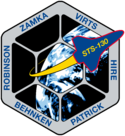George D. Zamka
| George David Zamka | |
 George David "Zambo" Zamka | |
| NASA-astronaut | |
|---|---|
| Född | 29 juni 1962 Jersey City, New Jersey |
| Tid i rymden | 28 dagar, 20 timmar, 32 minuter |
| Urvalsgrupp | Astronautgrupp 17 |
| Uppdrag | STS-120, STS-130 |
| Uppdragsemblem | |
George David "Zambo" Zamka, född 29 juni 1962 i Jersey City, New Jersey, är en amerikansk astronaut uttagen i astronautgrupp 17 den 4 juni 1998.
Rymdfärder
Media som används på denna webbplats
Colonel George D. Zamka, USMC, NASA astronaut
STS120-S-001 (February 2007) --- The STS-120 patch reflects the role of the mission in the future of the space program. The shuttle payload bay carries Node 2, the doorway to the future international laboratory elements on the International Space Station. On the left the star represents the International Space Station; the red colored points represent the current location of the P6 solar array, furled and awaiting relocation when the crew arrives. During the mission, the crew will move P6 to its final home at the end of the port truss. The gold points represent the P6 solar array in its new location, unfurled and producing power for science and life support. On the right, the moon and Mars can be seen representing the future of NASA. The constellation Orion rises in the background, symbolizing NASA's new exploration vehicle. Through all, the shuttle rises up and away, leading the way to the future. The NASA insignia design for Shuttle flights is reserved for use by the astronauts and for other official use as the NASA Administrator may authorize. Public availability has been approved only in the form of illustrations by the various news media. When and if there is any change in this policy, which is not anticipated, it will be publicly announced.
The official patch for STS-130. The shape of the patch represents the Cupola, which is the windowed robotics viewing station, from which astronauts will have the opportunity not only to monitor a variety of ISS operations, but also to study our home planet. The image of Earth depicted in the patch is the first photograph of the Earth taken from the moon by Lunar Orbiter I on August 23, 1966. As both a past and a future destination for explorers from the planet Earth, the moon is thus represented symbolically in the STS-130 patch. The Space Shuttle Endeavour is pictured approaching the ISS, symbolizing the Space Shuttle's role as the prime construction vehicle for the ISS.




